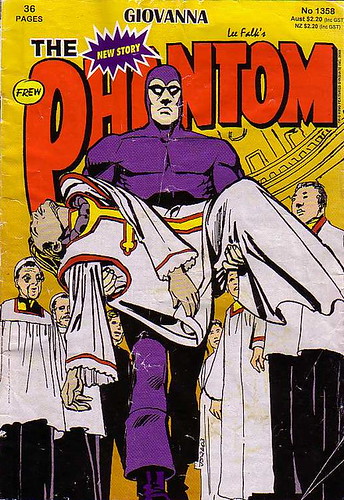
The Phantom #1358 (2003)
Writer, Ingebjorg Berg Holm; Illustrator, Dick Giordano
Frew Publications: Sydney Australia
1. While we have been moving though our superheroic ages here in the U.S. of A, from silver age silliness to grim 'n' gritty, with our variant covers and reboots and serial first issues, this publisher in Australia has been quietly publishing a Phantom comic book without interruption since September 9, 1948.
2. Who knew Dick Giordano, one of the grand masters of American comic book art, was still cranking out the comics? His work here, while nothing flashy, shows his consummate craftsmanship and a deep understanding of the form.
3. From the ancillary material in the comic and sources on the web, it is clear that Frew Publications is the keeper of the flame for the extensive mythology surrounding Lee Falk's character: references to the canon and attempts to reconcile the character's 400-year in-story continuity and sixty-year publishing history demonstrate a real respect for the source material.
4. This particular story is an adventure of the fourth Phantom in the early 17th century, read by the current Phantom to his twin children, Kit and Heloise (whom I think I have seen in the newspaper strip). I believe this is a common framing device in Phantom stories.
5. The main story, set in Rome, actually concerns intrigues within the Catholic Church. Plots, politics, betrayals, torture, and poisonings are all portrayed unapologetically as business-as-usual in The Vatican.
6. The Phantom gets involved in the story as he passes through Rome on a quest for his missing ring - the story of which appeared in the comic five years earlier, according to the editorial footnote.
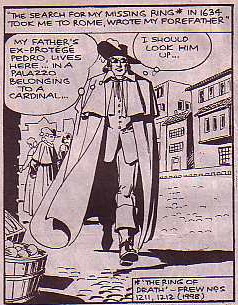
Kit Walker rockin' the shades as his plainclothes disguise, seventeenth-century style.
7. The Phantom not only finds himself drawn into the intrigues that killed his associate Pedro, but he finds himself strangely attracted to Cardinal Giovanni, with whom he suspects Pedro was having an affair. Here's The Ghost Who Walks confronting his own sexual confusion:
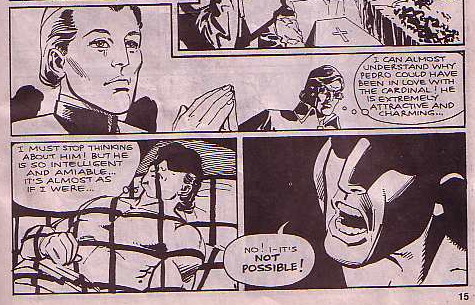
Don't fight the feeling...
8. Well, the cardinal is actually a woman after all! Giovanna and Pedro, young lovers, joined a monastery together to avoid being separated, managing to keep her sex a secret. They remained in the church and canoodled their way through the holy orders. Rather, Giovanni rose; Pedro was a bit of a late-renaissance slacker, and remained a monk (although he still got to snuggle a cardinal) until he was accidentally killed in a murder attempt on Giovanni.
9. The Phantom gets dragged deeper into the machinations within the church, and eventually he and Giovanna have an affair. While it's made clear to the reader what's going on with them, the current Phantom describes their first sexual tryst to the children as "Hmm... They... ehh... they embraced each other... for a long time." You'd think that a couple of kids being raised in the jungle to take over the mantle of a legend could handle a little sex.
10. While The Phantom is off following a lead on his ring, Giovanna plots and murders her way into the papacy to prove to her lover that she is strong and capable enough to be his bride without hiding in Bengali. Her Machiavellian methods prove too much for The Phantom, and of course, it all comes to a bad end, but not before we get this totally surreal confrontation scene:
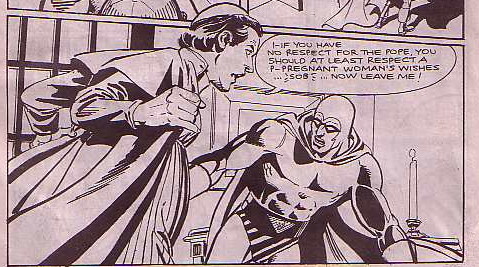
Wait, what?
11. The plot fulcrum for this story was based on the legend of Pope Joan, the apocryphal female pope of the ninth century, whose existence has been all but categorically disproved by historians, but who still holds a fascination for people: viz., this recent book and an upcoming movie with my own screen-crush Franka Potente.
12. In addition to the curiosity value of finding an Australian comic in a thrift store in Seattle and the serendipity of finding Giordano art inside, I was surprised at the relative maturity of the book. The sexual attraction between the characters, the cross-dressing and gender confusion, and the opportunistic and casual brutality of renaissance politics, not to mention the concern of the Church of Rome for matters of material wealth and power - all of these are portrayed frankly and openly, without any winks or nudges or hedging. I don't know who this Ingebjorg Holm is (and the internets didn't help any in finding out) but
Bonus: I just have to say that Fun Home might be the best graphic novel that I have ever read. I just got a copy this week, and I don't know what took me so long. Sometimes I am an idiot. As soon as I read this, I added it the syllabus for my class next quarter, Comics and Graphic Novels: Literary Technique in Sequential Art.
Don't be an idiot, too. If you haven't read this yet, do it now.
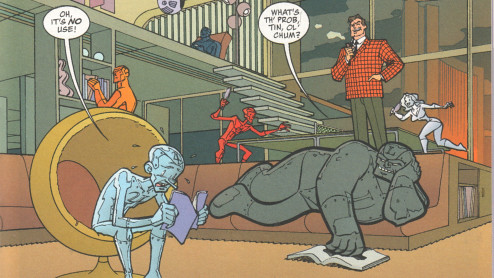


5 comments:
I think Ingebjorg Berg Holm must be a "she."
And I'm not entirely sure, but I don't think this story -- with its skepticism about the Church, crossdressing cardinals, extramarital affairs, pregnancy, and knowing if veiled references to teh gay -- is likely to be typical of what the publishers would allow in a kiddie comic. Is it possible Ingebjorg slipped this past them while no one was paying attention?
I picked up a stack of old Aussie Phantom comics in New Zealand a few years back, and saw nothing in them that would shock or disturb Ned Flanders. (Remember, this was the country that cut a scene from The Muppet Movie for excessive violence.) Now I want to go back through them and see if I was missing something!
Hiya, RAB! Of course you are correct about Holm - here's a little thing from 2003 I found with a better search:
"Ingebjörg is 22 years old, from Larvik but now studies art in Bergen. She revealed that she has been reading Fantomet since her teens (and it goes without saying that she is a member of the Norwegian Fantomet Club). Like many other young Norwegian comic creators she started at the Raptus festival by attending a course in scriptwriting and thus came to write a script for Fantomet. The story, Giovanna, is built on a legend of a female pope. This is a story that fits well with the mysticism surrounding the Phantom."
As for your "slipping past" theory: I don't think so. There's an extensive publisher's note in the comic, which refers to the story as "ultra-controversial" but which seems more concerned that the tale obscures the details of the death of the fourth Phantom's wife (whom he married in 1616) than anything that's actually in the story. Talk about continuity wanking!
Maybe this was the start of a bold, new era for Frew Publications!
Be darned! Well, I'm very glad to be mistaken...and kudos to them for taking a chance like that.
Incidentally, though I never heard of her before now, Ingebjörg is now the woman of my dreams. I mention this here in case she comes across this post during a Google search for her name.
Heh. The version of the story that was printed in Australia was actually a censored version of the original, which was printed in Norway and Sweden (try to google "Fantomet Giovanna" or "Fantomen Giovanna").
Originally, Giovanna was naked, more or less, in some of the pictures, but in Australia she had to wear a rather obscure-looking pyjama at night:)
I haven't actually read the Australian version, so I don't know if there are more differences, but my guess is that there are.
isla - Ingebjørg's proud cousin:)
http://www.tegneserier.no/default.asp?nyhetid=46
Post a Comment